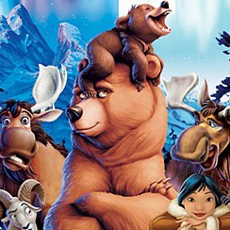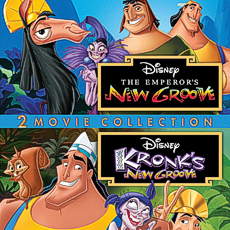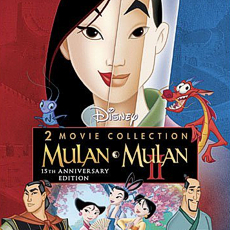Walt Disney Feature Animation (June 23 1995), Walt Disney Home Entertainment (August 21 2012), Blu-ray Disc plus two DVDs, 84 mins plus supplements, 1080p high definition 1.78:1 widescreen, Dolby Digital 5.1 Surround, Rated G, Retail: $39.99
Storyboard:
Set in the “New World” of discovery – America on the cusp of invasion by the British – Pocahontas is a Disney-fied retelling of the Native American Indian’s legend. When adventurer John Smith, accompanying the greedy Governor Ratcliffe and his hopes of finding riches, comes to shore and meets Pocahontas, it’s love at first sight, a powerful force bringing them together. When Ratcliffe finds out about Smith’s private encounter, he uses him as a way to locate the Indians, whom he sees as savages hording the “gold” for themselves. Pocahontas and Smith find their love in danger of becoming exposed and ripped apart by the events around them, and when Smith is captured by the Indians and Ratcliffe declares war, Pocahontas must choose which path she will ultimately take in trying to save those she loves…
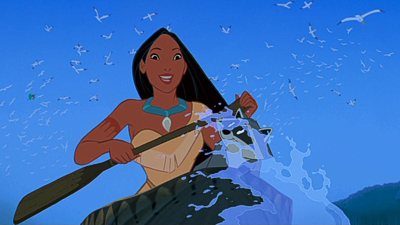
In the direct-to-video sequel, and as opposed to simply re-treading old ground, Pocahontas’ story uniquely continues (and along the same lines as history suggests, too!) when she travels from the Colonies to London in order to find Smith, who has gone missing after being accused of treason by Ratcliffe. Arriving as foreign royalty, Pocahontas is introduced to the heavyweights of British society, the charismatic John Rolfe among them, who by turns are amused by what they snobbishly assume are her simple ways and, in the case of Rolfe, just as struck as Smith was. Despite several attempts to undermine her by Ratcliffe, Pocahontas’ natural charm wins through and, when Smith is found, she is able to represent him against Ratcliffe’s claims. But then his reappearance raises an interesting and inescapable dilemma…
The Sweatbox Review:
Almost twenty years after Disney’s ambitious animated musical first debuted in theaters, this two-movie collection Blu-ray edition is a dynamic reminder of one of the Studio’s most overlooked and much-maligned features as well as its less distinguished but surprisingly faithful video sequel. After the box off punch of Beauty And The Beast and The Lion King in the early 1990s, Disney’s then Studio head Jeffrey Katzenberg was on a roll and determined to build on the mature aspects of these successes to create a blockbuster epic that would wow the Oscar Academy into handing out the first ever award for an animated Best Picture, which Beauty And The Beast had come close to with its nomination in 1992.
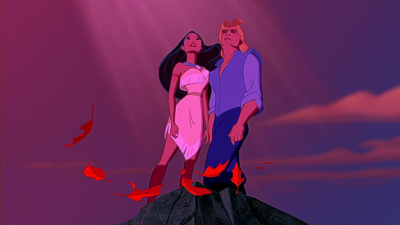
Again the answer lay in the story of a heroine – traditionally a Disney strong point before the rush of boys’ CG pictures – and again the artwork would be filled with the big, wide, broad strokes that had filled the canvases of Disney’s animation renaissance. And that’s where they pretty much came unstuck: trying, perhaps a little too hard, to catch lighting in a bottle for a second time. Though by no means the misfire that critics (and to an extent the Disney Studio itself) would have anyone believe, it is true that Pocahontas can be a little “long” for young kids to sit through, with its mysticism filling in for any real magical goings on, a villain who is more pompous than outwardly scary or theatrical, and a frankly adult tale of two people from opposite sides falling in love.
Though at the time of release Pocahontas was criticized for taking the true legend and playing fast with facts and figures, it’s important to remember that one is watching a Disney animated film here: an idealized version – as with many films – of events. True, Pocahontas’ age has been risen, though not as significantly as historians would have you believe, and John Smith has been transformed into a loveable rogue as opposed to the rather portly older man he was. But this is Hollywood romance time and to be fair the film sticks to the truth – spoilers ahoy! – that Pocahontas and Smith didn’t end up together and it wasn’t until the Indian princess later came to London that she would ever see him again.

Historical gripes aside then, the film plays through as a decent, mature, musical drama. That’s not to say it’s not suitable for kids – for many this is their first introduction to such films with some more layers and underlying themes to them. But perhaps the main fault with Pocahontas is that everything is done with much more of an earnestly solemn nature, with a forced gravitas that often doesn’t seem actually needed or work (Katzenberg would prove much more successful at this with his next Academy-luring attempt, the inaugural DreamWorks production The Prince Of Egypt). There were, in early drafts, animal character friends of Pocahontas that could talk, and perhaps this would have lightened the mood some, but they were cut in favor of a more introspective mood, where the creatures of Pocahontas are “real” animals, who do not speak and who merely follow her around for the fun of it.
Pocahontas’ actual confidant (a CGI/hand-drawn hybrid, much championed at the time) is Grandmother Willow, a mystically enchanted talking tree spirit who, one argues, could be a figment of Pocahontas’ own imagination and is planted simply in the spot where she goes to think and be by herself. In fact, most of all this works, and the only reason that Pocahontas may have really been derided on release may have been because of something deleted from the film in test screenings: a musical number, If I Never Knew You, that sealed Pocahontas’ and John Smith’s love, but which seemed to slow the film down and cause the youngsters to fidget.

The victim of much discussion on whether to leave it – and a couple of interwoven reprises – in or out, the song eventually ended up being almost totally animated during the course of production, eventually and ultimately rightly being reinstated, Human Again style, back into the film for a tenth anniversary DVD release. However, that version of the film – now the default choice for many as the filmmakers’ original intention – has outrageously not been included in this latest edition, the sequence again reverting to deleted scene status elsewhere on the disc. It’s a crying shame: with If I Never Knew You playing in the film, Pocahontas works so much better and certainly more coherently as a whole. The lead characters’ lives, which are so intertwined until this point (the moment happens late in the film, where Smith is being held captive), really needed some kind of final binding, and how better than to do this in a musical than with a powerful heartfelt song sequence?
Had If I Never Knew You premiered in the originally released edition, I have no doubt that Pocahontas would have been heralded as the kind of Disney film that intelligent adults could have gone and seen without the kids for once, and could have avoided the often used “too slow for kids, not enough depth for adults” routine. It’s certainly the edition of the film that I would argue should have debuted back then and be seen evermore: having If I Never Knew You in the film simply brings a more poignant closure to Pocahontas’ and Smith’s relationship and lifts the film to a new artistic level. Fans of the film who previously owned the CAV LaserDisc boxed set of Pocahontas will know that If I Never Knew You is good for a couple of other reasons too: it’s possibly Alan Menken’s strongest melody for a true love duet in a Disney film (Part Of Your World remaining the best “I want” song), and the recording, by Mel Gibson and Judy Kuhn, is an exemplary demonstration of exactly what a strong Hollywood musical performance should all be about.

If I Never Knew You is (was?) pure quality, folks, with a sweet, lilting harmony in the song’s final lines that will get you every time, and the song also nicely bookends a moment earlier in the Just Around The Riverbend sequence, which only further illustrates that it should have always been there. So it’s simply a huge disappointment that If I Never Knew You has been cut again when it plays as such an integral part of the movie, and Pocahontas and Smith’s relationship dynamic as well. As such, their connection feels more rushed and less consummated simply in an attempt to please the kinds of kids that were never going to get that much out of an animated history lesson anyway – Disney musical or otherwise!
Of the rest of the songs, anyone who has seen the film will know they are equally up there with the best of them, though I have to say that I became sick to death of the film’s signature Colors Of The Wind track due to massive over exposure both at the time of release, in the disc supplements on LD and in the two-disc DVD set, even though it remains immensely powerful. The songs really work because of Alan Menken’s growing prowess as a composer, and lyricist Stephen Schwartz, a composer himself who, one doesn’t wonder, continued to push Menken in the way that Howard Ashman had done, and not simply lend him free reign in the way Menken had taken the lead with Tim Rice. Schwartz, like Ashman, likes his words, and researches them well, delving deep into the subject matter to gather new meaning and reveal others, rather than Rice’s approach, which at times can seem trite and overly elaborate at the same time.
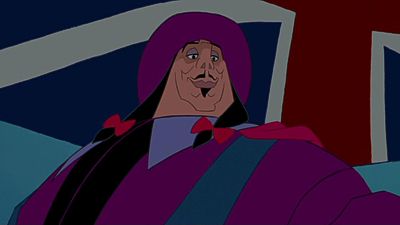
Sometimes, in trying to be too clever, Rice’s words don’t quite mesh and need further time after the fact to analyse them as opposed to Ashman’s direct and straight to the point wordplay or Schwartz’s multi-layered but deceptively simple lyrics. Menken has hopped from collaborator to collaborator in trying to find a fit as perfect as Ashman and still hasn’t worked with Rice again apart from the never realized King David. With Schwartz, he would go on to work on the even more demanding (both for the production and the audience) The Hunchback Of Notre Dame, before Schwartz departed and returned to composing himself the excellent songs for DreamWorks’ debut feature The Prince Of Egypt and later phenomenal stage success with The Wizard Of Oz prequel Wicked.
The rest of the score – the actual musical cues – doesn’t fare so well. The songs are great, but the score remains Menken’s blend of musical motif and often heavy-handed “Mickey Mousing” the action. He won another Oscar for it, so can’t have been doing too much wrong, but for me it feels a little light, and one must wonder what performers such as The London Symphony Orchestra might have made of it, or even what a more dramatic composer like Jerry Goldsmith would have fashioned. As such, the music serves the story well enough, and uses many of the songs’ main musical phrases as themes, which I always enjoy picking out and find lend themselves much better to an overall musical score, of which Pocahontas, along with Hunchback, is one of the most tightly woven in Disney films (and even more so with the If I Never Knew You insertion).

On the visual side of things, Pocahontas marked the directorial debut of Eric Goldberg, animator of Aladdin’s Genie and later animation director on Joe Dante’s Looney Tunes movie, Back In Action. Co-directing here with Mike Gabriel (The Rescuers Down Under, Lorenzo), there is little of the lively energy in the animation that usually personifies Goldberg’s (or Gabriel’s, for that matter) work. Everything, like the performances and music, is stately and a little too measured. It’s all done to an exacting perfectionism, of course, and there’s little to actually fault in the drawing, but for a film that really brings humans to the fore with such plotted passions, there’s precious little life in them. Likewise the backgrounds owe more to Sleeping Beauty (a fact I recall thinking on original release and is also acknowledged in the supplements here) though they come off as rather flat and one-dimensional.
This could be because since Pocahontas’ release we’ve become spoiled rotten by the Studio’s later Deep Canvas technique pioneered in Tarzan and the plethora of highly detailed CG pictures, but there is definitely more a feeling that this is the animated equivalent to watching a Hollywood movie shot on a soundstage than any other in the Disney line-up. Certainly, coming between the lushness of The Lion King and Hunchback, Pocahontas’ look is more muted, and the Earthy-feel, while intentionally keeping up the sombre mood, doesn’t always help things feel buoyant. One only needs to compare the opening storm at sea, which brings back memories of the much more magical sequences in The Little Mermaid, to witness the different approaches. Where the film does spring to life and color is in the song sequences, where sometimes bold and abstract images take over and the art directors can really have some fun.
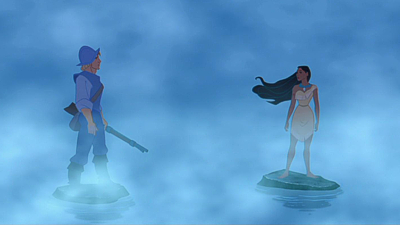
With If I Never Knew You in place, this approach to Pocahontas made more sense and one could finally acknowledge and appreciate the mature film that was being attempted. But, and even if the film is undeserved of its rather glum reputation, without the song playing as intended, it does come across as a colder, less involving film. Pocahontas and Smith’s first meeting is a masterclass in wordless cinema, something that the later song only bonded more powerfully, and should certainly not only have been included first time around, only being cut due to bored children in test screenings, but at least made an option here. I’ve never really understood why half finished animated films are shown to kids anyway: the cry of “where’s the color” on any pencil test puts off any youngster from sitting still, not least in a serious film like this.
Perhaps, but unbelievably, If I Never Knew You was only reconstructed in standard definition for DVD release and unable to make the transition to HD. That’s a pretty pathetic excuse, but if so then fans will want to hold on to their exhaustive two-disc set to see the film as it was intended. As something of a sweetener, Disney has elected to include the film’s made for video sequel Journey To A New World in this same package, although I fear the opportunity has been missed: who else, other than Disney fans who would have preferred the longer cut, will really be clambering to add a lackluster entry in the Studio’s library and a cut-price DTV title to their shelves?
Is This Thing Loaded?

Pocahontas was originally released on home video toward the end of the LaserDisc boxed set boom and got the royal treatment with a deluxe CAV edition that gathered a good deal of behind-the-scenes material and archived it for collectors. After that, Pocahontas was pretty much dumped on by Disney, who seemed to share the popular view that the film wasn’t worth a polish, until the tenth anniversary DVD provided multiple reasons (the If I Never Knew You sequence inserted into the movie being one of them) for DVD fans to catch up on all of that LD goodness, along with enough new features to entice LD collectors too.
Sadly, this Blu-ray and DVD Combo Pack doesn’t follow suit, dropping most of the supplements to find space to include the film’s sequel, made for video back in the days when “direct-to-video” was becoming an unpopular phrase when applied to Disney titles. Spinning any of the three discs (one BD, two DVDs for each feature) for the first time serves up the usual Sneak Peeks for forthcoming Disney discs and promos, including previews for Cinderella’s Diamond Edition, Finding Nemo’s 3D return to theaters, Tinker Bell’s Secret Of The Wings, The AristoCats, The Rescuers 2-Movie Collection, Beverly Hills Chihuahua 3 and Planes, also available in their own menu option.

Although not designated as such on the front packaging, where both films are given equal standing as a double feature disc, I’ve decided to bunch Pocahontas II: Journey To A New World (from 1998) with the supplements for two reasons. Firstly, it’s a direct-to-video sequel, one from the time that such things were giving Disney Animation a bad name, and although some of these films have been getting their own Blu-ray HD upgrades, those releases usually seem reserved for those that follow predecessors awarded Diamond Edition status so as not to tarnish the luster of those original features on their own releases. The rest of them, quite rightly in my view, should largely only be included as extras, which in a number of European countries they have been in the past.
Secondly, the double feature placing in this case still goes some way to showing that Disney is still unable to find it easy to trumpet the original film on its own merits. But Pocahontas was a film, a major release at the time, with high aspirations and with the prestige of coming from a reinvigorated Walt Disney Feature Animation at that! If the Studio itself can’t treat it with the respect it deserves – and the insertion, then removal again of If I Never Knew You indicates even they’re not sure – then at least I’ll strike a little blow against its lowering in status by having one of the so-called “cheapquels” standing alongside it, shoulder to shoulder. The only thing playing in opposition to my argument is that…Pocahontas II can actually be pretty good, albeit only in places and for a DTV title.

Clearing the downsides out of the way first is easy to take a swipe at in one go: even if the original film’s animation seemed a little flatter and more stylized than the features that immediately preceded and followed it, this effort’s artists struggle to capture the look entirely and it comes off as a pale imitation. The production outfit was Walt Disney Television Animation, before that unit branched out into the respectable crew that DisneyToon Studios would become, so the animation often falls pretty near the bottom of the Disney barrel in terms of artistry. While it doesn’t quite get as desperate as some of the Disney TV shows that sometimes felt as if they’d been inked with a black marker, there’s no denying that Journey To A New World is a much lower budgeted affair than the original film.
Even so, one has to fairly applaud the aspirations of the film: rather than just have someone else come to the American Colonies and battle against Pocahontas and her people, Pocahontas II does something that I don’t think any of the other DTVs ever managed: it actually continues her story (albeit as true to history as the first film was), developing new characters and, most impressively, transplanting the action to a new world (see what they did with the title there? Nice!) for Pocahontas herself when she travels to England to find John Smith (even if he doesn’t appear to have changed clothes since the last movie). This means a good deal of new art design in creating the streets of London, not a cheap way to go by any means and perhaps, as such, reflected in the film’s shorter running time, by almost ten minutes (68 minutes plus a five-minute credit scroll), which has the effect of rushing things through a little.

Where the movie really scores is in this expanded storyline, very loosely based on Pocahontas’ trip to London itself, where she did meet Smith again but by which point she was already attached to John Rolfe. These ever so basic facts provide the outline, but if one can get past the use of “history” as children’s drama then Pocahontas II becomes more enjoyable, what with the rogue Smith (actually a rather portly middle-aged man) jumping around rooftops and several anachronisms that provide their own entertainment, such as the liberal use of the Union Jack flag several years before it was adopted, a supposed William Shakespeare being inspired by the line “to be or not to be” despite having already written Hamlet (and dying) before Pocahontas came to England, or the fact that Ratcliffe had also died three years before she arrived.
But otherwise it’s actually quite good fun, even if the maturity of the first film is sorely missing in an aim to appeal to the repeat-watching kid audience (there’s way too much Flit, Percy and Meeko clowning around) and the situations feel lifted from what could be the continuing adventures of Pocahontas from a Disney television spin-off: Ratcliffe’s persistence at denouncing the princess to ridiculous cost to his own credibility, a ship-set battle towards the film’s end (not as good as an early jail break sequence) and a final resolve particularly seem too closely akin to the kind of thing that plays better in Saturday morning cartoon fare. But on the flipside, Bedard returns to vocally portray Pocahontas, and she’s again joined by David Ogden Stiers, deliciously reprising his theatrical Ratcliffe, while other original cast members Linda Hunt and Russell Means vocally cameo as Grandmother Willow and Powhatan respectively, with Jim Cummings making for an unusually stern King James.

Not returning – but you’d never know unless you read the credits – is the vocalist for Smith himself, although he is still performed by a Gibson, in this case the younger brother of “mad Mel”, Donal. Like Tom Hanks’ sibling, who steps in for some of his lesser Toy Story assignments, Donal is the vocal spit for his brother, and the transition is as seamless as to not even be worth mentioning. Perhaps adding a bit more of the star wattage the lesser-known Gibson brings to the voices is Billy Zane as Rolfe, a big deal actor at the time having just come off a little movie called Titanic, and a really good fit for the character, giving him a rare-ish chance to play the good guy for a change. On top of this, long-time Clint Eastwood collaborator Lennie Niehaus gets his chance to make a mark in animation and suitably provides a stirring score that does its job nicely in recalling the original while drawing on the melodies for this film’s new songs.
So Pocahontas II is pretty good then, right? Well, yes and no, and more on the no, because whatever good the writers’ ambitious plot, established voice cast and directors Tom Ellery and Bradley Raymond bring to the project the largely Japanese-animated action throws away. There’s a pretty nicely directed opening, set in the London night fog where Smith disappears (even if the rather lame “Walt Disney Home Video Presents” banner then kind of detracts from the aspirations on show), on the whole Ratcliffe is remarkably animated for this kind of production, and Pocahontas’ hair mostly keeps nicely moving fluidly all the time, but ultimately the film struggles to break free of its DTV confines just as much as it leans continually on the spirit of Pocahontas’ mother in the never-ending multi-colored leaves that keep blowing around. Characters are flatly colored and appear one-dimensional, sometimes too noticeably rotoscoped, and structurally things are planned so that commercials could cut in every 18 minutes or so.

And then there are the songs, and Marty Panzer and Larry Grossman’s forgettable ones fall into the usual pitfall for such projects in being “too Disney”, often either producing carbon copy tunes typical of the genre and/or going overboard in trying to make up for any other shortcomings by having their vocalists over-perform as histrionically as possible. Obvious moments in this regard here include the What A Day In London cast number, sung by a chorus of “cor blimey, guv” storybook Londoners who may as well be singing the opening Belle from Beauty And The Beast but with embarrassingly pedestrian lyrics that don’t scan properly. Things Are Not What They Appear may be one of the film’s highlights, and Wait ’Till He Sees You perhaps the sweetest, less frantic, number, but even here the vocalists remind us too strongly of The Hunchback Of Notre Dame’s Clopin and Mrs. Potts’ Angela Lansbury (there’s that Beauty And The Beast again!), respectively.
Likewise, in Pocahontas’ supposedly soul-searching Where Do I Go From Here?, another badly scanned lyric, she is again performed in song by Judy Kuhn but seems more interested in just hitting the high notes so as to bring some surface emotion to the sequence as opposed to finding any true emotion within it and herself. This is something that could be said about the movie as a whole, which all goes to say that, although creatively Pocahontas II has a good stab at being a valid film that can stand on its own merits, artistically it just can’t hold a candle to the original film; mostly this is down to the animation and songs, since the story is pretty robust. Unfortunate that this is, because Journey To A New World could almost have made it to its destination, but ultimately sinks along the way.
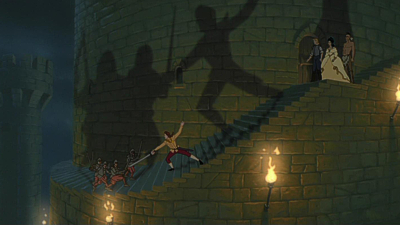
On the Blu-ray, and despite the sequel taking up a fair chunk of the disc’s real estate, there’s still a little room to carry over a mix of some previous Pocahontas supplemental material and, to be fair, a couple of new additions too, starting with Drawing Inspiration: The Lost Story Of Hiawatha (11:49 in HD). Taking a look at one of Disney’s never-made features, animation historian and author of the excellent book The Disney That Never Was, which chronicles the many productions that didn’t make it through development, Charles Solomon reveals previously unseen artwork that depict what would have been a very different departure from the usual Disney style. Picking up where Solomon leaves off, Pocahontas filmmaker Eric Goldberg explains how the proposed film’s artwork influenced their own native American tale several decades later – and some of the similarities are striking – and, even more excitingly, runs us through a story sketch presentation of Hiawatha’s entire plot.
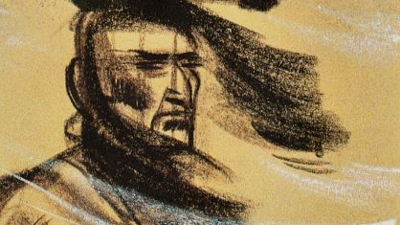
Really nicely assembled and presented, this material may well only be loosely connected to the Pocahontas feature Goldberg co-directed, but it’s good to see Disney attempting to find new things to highlight their catalog titles and there’s an exceptional amount of sometimes breathtaking imagery here for a dark and seriously minded picture that one just couldn’t have imagined to have been developed throughout the 1940s when the light and frothy Package Features kept the Studio afloat. Attentions shifted to the potentially sure-fire bet Cinderella as money got even tighter after World War II, and so Hiawatha was never animated; judging by this presentation it may have been too sombre to be a hit at the time, but this is a unique and fascinating look into a “lost film”. As if to tie up loose ends in relation to Walt’s dealing with the subject, his classic Silly Symphony Little Hiawatha cartoon is included, even though this much earlier animated short, from 1937 and taking its comical cue from Longfellow’s poem, has nothing to do with Walt’s feature idea or the subsequent Pocahontas movie, but it’s a natural inclusion and a nice extra for collectors.
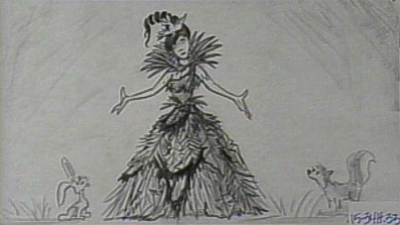
Carrying over producer James Pentecost and co-directors Eric Goldberg and Mike Gabriel’s remarks for the tenth anniversary edition (but not the tenth anniversary cut itself!), the Audio Commentary featured here has been pruned of the talk that covered the If I Never Knew You sequences, with the discussion simply cutting out for that point. It’s a shame, really, that the newer track (with the trio speaking eight years after original release) was used here since DVD collectors will have already heard it and they may have perhaps preferred to have listened to the rarer original 1996 LaserDisc track instead, which additionally featured Alan Menken, Steven Schwartz, art director Michael Giaimo and co-writer Carl Binder, and was a lively discussion. Here, the three offer up their more retrospective recollections of working on the film, touching on the balance of drama and comedy, the depiction of the native American Indians, and the two peoples’ language barrier. It’s still a cracking, typically filled fun and intelligent Disney animation discussion, if not quite as in depth as the original, packed LD track.
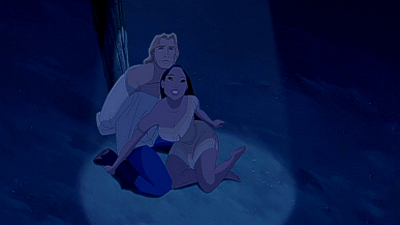
If I Never Knew You had to be touched upon somewhere in this set, so here it appears as a Deleted Song and accompanying a series of Deleted Scenes. Essentially, the entirely completed sequence is presented as a stand-alone clip, without the later reprises as Pocahontas says goodbye to Smith being mentioned at all. The optional commentary from the filmmakers is lifted as a whole from the same moment’s placing in the tenth anniversary DVD edition, and so their remarks about being so pleased to have it back in the movie where it belongs are doubly frustrating in that it has been taken back out of the film again! The original intention to have the song feature heavily in the film and throughout the score is clear and there’s never any doubt that this is the filmmakers’ preferred version, the multiple comments about the maturity the sequence brings to the film ringing ever so true and debating how an adult audience might have better responded to the original release had it been left in as intended.

The Deleted Scenes are a mixed bag of what we have seen before, presented individually but in an optional single line-up that offers no context, explanation or introduction to what they are or what we are seeing. The footage may remain the same as has been seen on the original LD and subsequent tenth anniversary DVD, but here the optional commentary on some of the clips has been dropped. Included are Below Deck After Thomas’ Rescue, the deleted song Dancing To The Wedding Drum, a Transition To Just Around The Riverbend, Pocahontas Dresses As An English Woman, Wiggins Gets Mud Thrown At Him and the alternate to Colors Of The Wind song In The Middle Of The River.
John Smith Escapes and a Just Around The Riverbend Reprise finish off the alternate ideas, but still missing (as shown on the LaserDisc) is an alternate version of Colors Of The Wind with different lyrics and visual treatment. Rounding this selection up is a little grouping of abandoned animation snippets that feature several alternative scene choices (an alternate Mine, Mine, Mine closing shot in full color being a favorite) and scene extensions. Primarily a series of storyboards, there’s also a healthy dose of pencil test animation and even a smattering of fully colored shots, and all told these clips (including If I Never Knew You run to over twenty minutes.

The Music Of Pocahontas is another straight LD lift, being a seven-minute piece on the songs and score, an obviously important element in Pocahontas. Producer Pentecost, composer Menken and lyricist Schwartz explain the thought process behind the creation of the music and there again is a generous amount of behind-the-scenes footage (including the duo working on the deleted song In The Middle Of The River) and singer Judy Kuhn singing the signature Colors Of The Wind in the sound booth, but without context this does feel like has been cribbed from a wider-reaching presentation, which the LD and previous DVDs were.
Pocahontas II doesn’t have any bonus features, and that’s unbelievably it for the original Pocahontas too…the rest of the supplements can be found online only via the dreaded return of the Disney Virtual Vault. I’ve complained about this useless way of Disney consigning some of their biggest titles’ extras to the online void on the previous Fantasia and Lion King releases, but the Studio seems intent on pulling back from providing, say, an extra DVD’s worth of extras in their sets to save some manufacturing money while still charging full premium for the package. In this case, I’d have much preferred to simply have the Blu-ray dedicated to Pocahontas and left the video sequel as a DVD bonus only, or split the missing extras across both those discs (neither of the FastPlay enabled enclosed DVDs, one for each feature, offer anything of worth except for The Music Of Pocahontas and a Pocahontas II DVD Storybook respectively).

Once again, what happens when Disney decides to remove that content from the web or, in the case of this disc where, although it’s region coded for AB and C zones, this BD-Live powered content is available only in the USA and Canada, reducing international fans’ enjoyment enormously unless they have a PC and a BD drive that can overcome such restrictions. Thankfully, most will already have the excellent tenth anniversary set that features the intended cut of the movie and the majority of known supplements, but this is again a poor show for a title that the Studio obviously just wants to do the bare minimum in upgrading. The process itself is problematical too, with constant buffering and freezing of the image as a stream tries to play, and a lack, even more strangely, of having all of the bonuses to hand: looking around the web it sounds as if, even in this form, the half-hour, Bedard-hosted Making Of Pocahontas is missing along with much on the promotion and original release of the film (there are no trailers or footage of the Central Park premiere).
The rest of what should be online seems to be a mix of some of the featurette clips and sing-alongs randomly cherry picked from the previous editions. I say seems to be since, as apparently as so many others, I couldn’t actually get the lousy Virtual Vault to even open, despite no problem connecting to other online content providers through my BD or BD-ROM players. So without any kind of listing as to what one might expect to find we may as well take it as read that those extras simply haven’t been carried over to this particular disc, despite its contents not reaching anywhere near the maximum capacity for the format. I think we just found the front-runner nomination for most disappointing Disney disc of the year…
Case Study:
Disney’s now standard Blu-ray design lines continues with the Pocahontas: 2-Movie Collection, the double-feature presentation splitting the front image into two halves to present the characters of each film on each side, with Pocahontas front and center, but remarkably not one decent image of John Smith even though Pocahontas finds herself repeated on the sequel’s side of the glossy, embossed slipcover. An insert offers the Movie Rewards code for the title, while one of the front stickers offers $10 off the title when purchased with another of Disney’s August 21 releases, good up to September 30 2012.
Ink And Paint:
Previously presented in its “original aspect ratio” of 1.66:1, Pocahontas is here transferred to a more HD-friendly 1.78:1 frame, essentially cropping off the very top and bottom of the image. There isn’t a great deal lost, and I’m more prone to let these things slip on the direct to video titles (such as Pocahontas II, which gets the same treatment), but I can’t see why Disney keeps insisting on making these changes when the 1.66 frame offers more of the original negative ratio information and still fills a 16:9 display where overscan would mask any sliver of black on each left and right side. Other than this the image is certainly an improvement over anything that has come before, the BD format reducing the banding of previous DVDs and showing off the delicate animation.
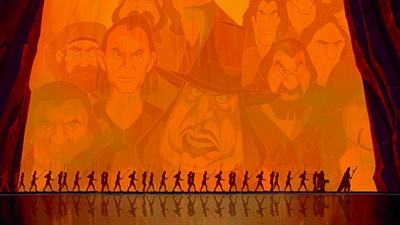
Color has also been desaturated a little, to provide more of a welcome muted look than the tenth anniversary edition which pushed the brightness levels more (the only instance of this transfer being preferable to that one). The increased resolution is something that only hinders the sequel’s presentation, showing up every flaw in the animation, as well as, it must be said, some of the better artistry. Pocahontas II really does try hard, especially in its direction, but the whole video feel, right down to some aliasing on the wide shots of some of the ships, bogs it down to a lower level that can’t compete with the artistry of the original.
Scratch Tracks:
Where the sequel does manage to hold up is in its soundtrack, here presented as for the first film in DTS-HD Master Audio. The 5.1 on both films is evoked pleasantly, although obviously the bigger budget original gets all the bells and whistles. The mix is very much in favor of the music, which fills out the soundtrack, but when that dies down, such as the beautifully judged waterfall meeting, we still get a total sense of awareness from the track. Pocahontas isn’t a particularly action filled feature, leaning more on passionate dialogue and stirring songs to heighten emotion, but when that emotion comes it does resonate as intended. English, French and Spanish Dolby dubs and subs are all optional.
Final Cut:
As the punchline to the old joke goes… “What’s a hontas?”
Environmentally friendly before it was cool to be seen to be, Pocahontas is still a middling film that will divide new audiences in its theatrical edition. Without the If I Never Knew You sequence in place it goes from being more deeply moving to the rather po-faced affair that dented its box-office and, probably, award-seeking recognition too. The music is great, and the animation as fluid and exemplary as ever, but there’s just a lack of something that lifts the rest of the film up to their level…and that something is – I’m sorry to keep banging the drum on it – the inclusion of If I Never Knew You!
Without it in place here, and hugely disappointing without the wealth of bonus features that have been dropped to include an okay but ultimately frustrating sequel (that almost unwittingly undoes the work of the original), you’ll have to decide whether to keep your much better tenth anniversary DVD set or if you really have to have the theatrical version of Pocahontas on Blu-ray, because the Hiawatha material aside there’s really little else of real value here. The tenth anniversary suggested Disney was ready to treat the film with the respect it deserved in that version, but that respect has been thrown out here: the curse of the insanely lame Virtual Vault scoring another self-inflicted hit against its reputation.
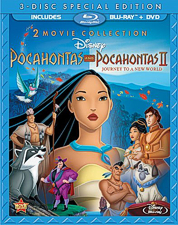 | ||
 |









